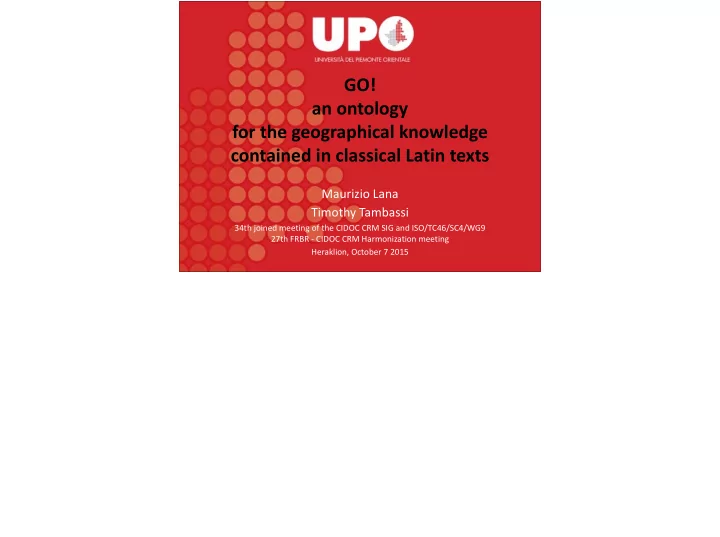

GO! ¡ an ¡ontology ¡ for ¡the ¡geographical ¡knowledge ¡ contained ¡in ¡classical ¡Latin ¡texts Maurizio ¡Lana ¡ Timothy ¡Tambassi ¡ 34th ¡joined ¡meeting ¡of ¡the ¡CIDOC ¡CRM ¡SIG ¡and ¡ISO/TC46/SC4/WG9 ¡ 27th ¡FRBR ¡-‑ ¡CIDOC ¡CRM ¡Harmonization ¡meeting ¡ ¡ Heraklion, ¡October ¡7 ¡2015
Geolat ¡ ¡ geography ¡for ¡Latin ¡literature Geolat ¡is ¡a ¡research ¡project ¡aimed ¡at ¡offering ¡access ¡to ¡a ¡ digital ¡library* ¡of ¡the ¡Latin ¡literature ¡(from ¡its ¡origins ¡ to ¡the ¡end ¡of ¡the ¡Roman ¡Empire) ¡through ¡a ¡query ¡ interface ¡of ¡geographic/cartographic ¡type ¡ representing ¡the ¡geographic ¡knowledge ¡expressed ¡in ¡ the ¡texts ¡themselves ¡ * ¡see ¡digilibLT-‑ ¡www.digiliblt.unipmn.it ¡ the ¡project ¡is ¡funded ¡by ¡Fondazione ¡Compagnia ¡di ¡San ¡Paolo 3
Geolat ¡ ¡ geography ¡for ¡Latin ¡literature the ¡members ¡of ¡ our ¡research ¡group: ¡ historians ¡(gabriella ¡vanotti), ¡philosophers ¡of ¡mind, ¡of ¡science ¡and ¡ other ¡(cristina ¡meini, ¡margherita ¡benzi, ¡timothy ¡tambassi), ¡ computer ¡scientists ¡(diego ¡magro), ¡latin ¡scholars ¡(alice ¡borgna), ¡ geographers ¡(raffaella ¡afferni), ¡comparatists ¡(fabio ¡ciotti), ¡ library ¡& ¡information ¡science ¡(maurizio ¡lana) ¡ ¡ and ¡last ¡but ¡not ¡least ¡we ¡work ¡with ¡three ¡professional ¡ontologists: ¡ claudia ¡corcione, ¡paola ¡de ¡caro, ¡silvia ¡naro, ¡who ¡are ¡the ¡ authors ¡of ¡the ¡ontology ¡ 3
relevant ¡similar ¡projects Pleiades ¡ Pelagios ¡ pleiades.stoa.org pelagios-‑project.blogspot.co.uk 4 Geolat ¡adopts ¡a ¡geographical ¡ontology ¡for ¡the ¡human-‑made ¡annotation ¡of ¡the ¡placenames ¡in ¡the ¡texts,ile ¡Pelagis ¡adopts ¡an ¡approach ¡parsing+NER
why ¡using ¡ontologies ¡? describing ¡ (aspects ¡ of) ¡ the ¡ content ¡ of ¡ a ¡ text ¡ using ¡ the ¡ categories ¡(the ¡classes) ¡of ¡an ¡ontology ¡allows: ¡ to ¡act ¡ in ¡the ¡text ¡as ¡interpreters ¡(writing ¡the ¡annotation ¡itself) ¡ to ¡do ¡searches ¡based ¡on ¡some ¡type ¡of ¡mixed ¡reasoning ¡(“which ¡ are ¡ the ¡ fresh ¡ waters ¡ occurring ¡ in ¡ the ¡ works ¡ of ¡ Augustan ¡ writers?”) ¡ to ¡build ¡factual ¡connections ¡among ¡different ¡texts ¡– ¡so ¡putting ¡ them ¡ in ¡ relation ¡ beyond ¡ times ¡ (which ¡ places ¡ of ¡ Roman ¡ Antiquity ¡are ¡mentioned ¡in ¡French ¡Renaissance ¡texts?) 5
GO!: ¡the ¡Geolat ¡Ontology general ¡aims : ¡ • accessibility ¡ (both ¡ for ¡ the ¡ scientific ¡ community ¡and ¡for ¡general ¡public); ¡ ¡ • informativeness; ¡ ¡ • completeness; ¡ • reuse ¡and ¡interoperability. 6
GO! ¡reuse ¡and ¡interoperability reuse: ¡ • the ¡ontology ¡is ¡made ¡of ¡4 ¡different ¡modules ¡which ¡can ¡be ¡used ¡ alone ¡ • there ¡are ¡horizontal ¡modules ¡collecting ¡shared ¡features ¡(TOP) ¡and ¡ vertical ¡modules ¡which ¡go ¡into ¡detail ¡of ¡a ¡given ¡subdomain ¡(HUM, ¡ PHY, ¡FAR) ¡ interoperability: ¡ • GeoSPARQL, ¡which ¡is ¡an ¡OGC ¡(Open ¡Geospatial ¡Consortium) ¡ standard ¡is ¡imported ¡and ¡reused ¡ • the ¡mapping ¡with ¡some ¡of ¡the ¡most ¡relevant ¡geographical ¡ ontologies ¡(or ¡containing ¡a ¡relevant ¡geographical ¡part) ¡is ¡declared 7
GO!: ¡the ¡Geolat ¡Ontology specific ¡aim : ¡ • describe ¡geographical ¡information ¡contained ¡in ¡ Latin ¡texts ¡– ¡the ¡first ¡development ¡started ¡from ¡ the ¡ analysis ¡ of ¡ Caesar, ¡ Sallust, ¡ Tacitus, ¡ Lyvi, ¡ Ammianus ¡Marcellinus; ¡ • provide ¡an ¡inventory ¡of ¡classes ¡and ¡relation ¡in ¡ order ¡to ¡annotate ¡semantically ¡Latin ¡texts ¡ 8
GO!: ¡some ¡necessities GPS ¡coordinates ¡of ¡ evolution ¡of ¡a ¡given ¡ historical ¡events ¡ the ¡places; ¡and ¡ place ¡(e.g. ¡from ¡ description actual ¡names ¡if ¡any village ¡to ¡city) physical ¡and ¡ connection ¡with ¡ geopolitical ¡ management ¡of ¡ places ¡data ¡in ¡ description ¡of ¡a ¡ imaginary ¡places Pleiades given ¡place connection ¡with ¡the ¡ connection ¡with ¡the ¡ Open ¡Annotation ¡ Barrington ¡Atlas ontology ¡to ¡cite ¡the ¡ passages 9
GO! ¡faces ¡some ¡problems we ¡can ¡distinguish ¡three ¡different ¡kinds ¡of ¡problems ¡dealt ¡with ¡by ¡ ancient ¡geographers, ¡which ¡share ¡lack ¡or ¡vagueness ¡of ¡available ¡data ¡ and ¡information, ¡and ¡assume ¡a ¡central ¡role ¡in ¡GO: ¡ • topological ¡problems ¡ (we ¡must ¡correctly ¡interpret ¡the ¡descriptions ¡of ¡ the ¡places ¡– ¡more ¡correctly ¡than ¡‘before’); ¡ ¡ ¡ • source ¡problems ¡ (lack ¡of ¡reliability ¡and ¡homogeneity ¡of ¡some ¡data, ¡ disagreement ¡among ¡different ¡authors, ¡etc.); ¡ • methodological ¡problems ¡ (heterogeneity ¡of ¡aims, ¡points ¡of ¡view, ¡ interpretations ¡and ¡perspectives, ¡use ¡of ¡assumptions ¡and ¡models ¡ representing ¡cosmos, ¡attempts ¡to ¡make ¡the ¡data ¡more ¡consistent, ¡ etc.). 10
GO! ¡modules ¡(OWL2) Top Phy Far Hum 11
GO-‑TOP contains ¡the ¡most ¡general ¡classes ¡and ¡ properties, ¡which ¡would ¡be ¡repeated ¡ in ¡all ¡the ¡other ¡modules ¡ ¡ Imported ¡Ontologies ¡ Geosparql 12
GO! ¡selected ¡classes Thing passage event lenght spatial ¡ref. ¡ spatial ¡ sys. ¡id. object ¡ (from ¡ Geosparql) historical ¡ natural ¡ location position geometry event event 13
GO! ¡selected ¡classes Thing mithologic temporal ¡ unit ¡of ¡ historical ¡ temporal ¡ entity ¡ al ¡entity entity measure ¡ entity ¡ entity name historical ¡ historical ¡ geographi historic ¡ Person ¡ character ¡ group c ¡entity ¡ entity ¡ name name name ¡ 14
Object ¡Properties about ¡space : ¡above, ¡below, ¡borderToTheEast, ¡borderToTheNorth, ¡borderToTheSouth, ¡ • borderToTheWest, ¡hasLocation, ¡hasRealPlace, ¡hasSRID, ¡identify, ¡inPlace, ¡inSRID, ¡ isUnder, ¡leftOf, ¡nearby, ¡rightOf, ¡visibleFrom, ¡beginningPlace, ¡endingPlace, ¡partOf. ¡ about ¡time : ¡after, ¡before, ¡occurIn. ¡ • about ¡names : ¡deriveFrom ¡(it ¡describes ¡how ¡the ¡meaning ¡of ¡a ¡placename ¡depends/is ¡ • derived ¡from ¡another ¡name ¡or ¡entity), ¡hasNAme, ¡nameOf. ¡ about ¡actors : ¡becomes, ¡wins, ¡composedBy ¡(it ¡describes ¡by ¡which ¡persons/parties/ • populations ¡an ¡alliance/formation/line-‑up ¡is ¡made), ¡owns, ¡foughtBetween ¡(it ¡connects ¡ a ¡battle ¡with ¡the ¡involved ¡parties), ¡hasPath, ¡hasStopOver(it ¡allows ¡a ¡journey ¡path ¡to ¡be ¡ subdivided ¡into ¡legs), ¡involves, ¡isStopOverOf ¡(it ¡indicates ¡a ¡leg ¡of ¡a ¡path/route), ¡ objectOf, ¡subjectOf ¡(see ¡the ¡external ¡doc ¡explaining ¡the ¡ontology, ¡sect. ¡4.1.3), ¡to, ¡by, ¡ passesThrough, ¡controls, ¡belongsTo. ¡ about ¡measurement : ¡hasLength; ¡measuredBy ¡(it ¡connects ¡a ¡lenght ¡to ¡a ¡unit ¡of ¡ • measure). 15
Recommend
More recommend